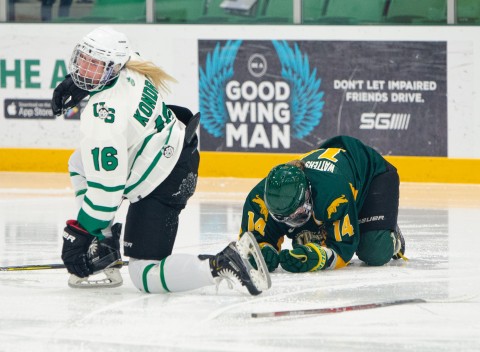The University of Saskatchewan is home to a lot of interesting research, but much of it goes unnoticed by students as they go through their day-to-day lives. One researcher, however, is making great strides in the field of traumatic-brain-injury detection.
Once, in high school, I attended a basketball team pep rally. The gym was packed, Kanye blared from the speakers, and a few hundred people were squeezed into the bleachers. We watched as 25 lanky, acne-ridden but athletic teenagers bounded up and down the court, showing off their dunking skills.
I vividly remember one kid — gangly, mop-headed and last in line — who happened to begin his dunk just as the music ended. The first half of the dunk was immaculate. He lept into the air like some sort of gazelle, guiding the ball delicately into the hoop.
He absolutely butchered the landing, though. His high tops couldn’t quite grip the floor, and his feet were thrown into the air in front of him, which was followed by the crack of his head hitting the ground and the ominous hiss of the entire crowd sucking in air through gritted teeth. He was okay — possibly concussed — but he walked it off, so no harm done, right?
Well, modern research doesn’t really agree. Concussions are now referred to as traumatic brain injuries, which sounds far more sinister, and for good reason. We’ve found that any impact forceful enough to cause a concussion — say, a dirty football tackle, a diving-board mishap or whiplash from a car accident — can lead to profound changes in the functioning of the brain.

U of R Cougars defenceman Nikki Watters-Matthes lays on the ice after a collision with U of S Huskies forward Kara Kondrat.
A concussion happens when an impact or sudden violent movement of the head causes the brain to slosh around inside the skull, which is not good for such a delicate organ. Imagine scrambling an egg without cracking the shell.
Dr. Changiz Taghibiglou is a researcher and professor in the physiology and pharmacology department at the University of Saskatchewan.
Early on in his career, Dr. Taghibiglou worked as a medical officer at a field hospital in Iran, where he saw many soldiers who had been admitted for “blast-wave concussions.” Despite the force they’d been exposed to, there were often no visible signs of injury.
Dr. Taghibiglou was faced with a challenge — how do you diagnose a TBI if there are no visible signs you can look for? There were no broken bones to X-ray, no blood tests he could order and no MRI machines. The soldiers would be kept in observation for a few days and then discharged. According to Dr. Taghibiglou, “a large percentage of these soldiers went on to develop psychiatric issues later in life” — something that is also seen in athletes who play contact sports like football, hockey and wrestling.
“In order to develop a simple blood test, which could be used to diagnose TBI, you need to figure out what the ‘biomarkers’ of brain trauma are,” Taghibiglou said.
Biomarkers are molecules that can be measured in a person’s blood that tell you something about their health. For example, someone with abnormally high blood sugar might have diabetes. By studying Huskies athletes, Dr. Taghibiglou and the students in his lab successfully identified two biomarkers that are elevated after a TBI.
One of the molecules, called cellular prion protein or PrPC, likes to hang out on the surface of cells in the brain.
“During head trauma,” Taghibiglou said, “PrPC is knocked off those cells, making its way into the bloodstream,” where it can be detected by a blood test.
Dr. Taghibiglou’s concussion study was funded by the Department of National Defence, but he needs more funding to be able to bring his biomarkers into the public eye.
Dr. Taghibiglou notes that, when it comes to securing research grants, the U of S is at a slight disadvantage.
“Smaller universities like the U of S are not as competitive as bigger institutions like McMaster or UBC,” Taghibiglou said.
Often, the U of S is forced to rely on philanthropic donations or crowd-based funding, so it’s worth remembering that, the more people donate, the better off you are next time you take a spill on the ice, fall off of a grain bin or get into a fender-bender on Cumberland.
Despite our small size, there is a huge amount of potential here at the U of S. We have some very talented researchers, who will no doubt make potent contributions to the world of medicine.
—
George-Paul O’Byrne
Photo: Yashica Bither